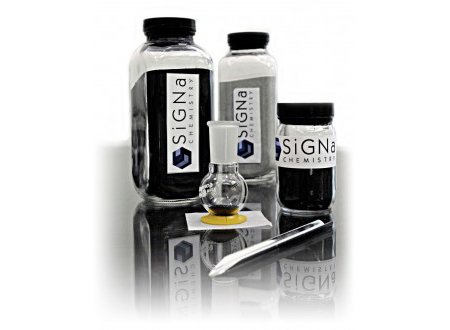Behind every successful green technology product is a host of innovators bringing together the pieces to make an electric car or solar water heater in the home more efficient. Many of these innovators, if not working for the company building the green product or service, often have small operations of their own which work diligently on building the better eco mouse trap. SiGNa Chemistry could easily be one of those.
SiGNa Chemistry turned up on the green tech radar last year with a portable fuel cell system designed to work with an electric bike. The company, which in 2008 garnered a Presidential Green Chemistry Challenge Award “for innovations in green chemistry materials based on the company’s proprietary technology for nano-scale encapsulation of reactive metal materials,” continues to quietly tinker away on a platform it feels could have a wide array of applications for cleaner fuels. We recently interviewed Michael Lefenfeld, SiGNa’s president and CEO, to learn more about the company.

EarthTechling (ET): What is the story behind Signa Chemistry? What inspired its formation?
Michael Lefenfeld: I spent many years working with reactive alkali metals and experienced first hand how dangerous these products could be, not only in the chemical process but through their by-products. I saw an opening to fill a need; to create safe, scalable reactive metals. This was the birth of SiGNa Chemistry. I knew from the start that the potential applications for safe reactive metals was limitless and could impact a number of industry’s from consumer electronics and pharmaceuticals to petrochemicals, fine/specialty chemicals, even environmental remediation.
In fact, in 2005, we saw a need in the hydrogen space, in terms of generation, specifically a way to solve the storage problem. Using sodium silicide, a safe non-combustible powder, we were able to develop a power solution that produced clean hydrogen on demand.
ET: What exactly is “green” chemistry mean to you?
Lefenfeld: We never set out to necessarily create “green” chemistry, but in order to be a successful scientist it is necessary that the chemistry you create is efficient, environmentally-friendly and sustainable. This should be the foundation that every chemist builds off of and when you do that your product is destined to be “green.”
ET: Talk about Signa’s portable power system. What makes it interesting and unique?
Lefenfeld: Hydrogen fuel cells have promised for years to be the solution that moves the United States from a petroleum-based economy to a cleaner, hydrogen one. But lingering technical hurdles have prevented fuel cells from being commercially accepted; market viability always seems to be just a few years or one more technical breakthrough away.
SiGNa Chemistry’s proprietary chemical process solves both of the most vexing fuel cell problems – storage and the difficulties of generation – through a power solution that creates hydrogen inexpensively and in real-time, using a mix of water and sodium silicide, as needed, and at less pressure than a soda can.
In fact, the power solution, which emits zero green house gas and can be produced at ten times less the cost of an alkaline battery (6x times less than disposable lithium batteries), eliminates the safety risks normally associated with hydrogen supply systems, while overcoming the logistic difficulties and high costs of refilling high-pressure tanks.
Unlike many alternative energy fuels, SiGNa Chemistry’s power solution is already on the market and we’ll see an increase in use in consumer electronics, emergency and even disaster preparedness. The scaling up of the sodium silicide power solution can achieve large-scale results. For instance, since a generator using the power solution could even be powered by mixing the sodium silicide solution with muddy water – we could even help bring electricity to third-world countries.

ET: Why did you choose to tie this power system to an electric bike?
Lefenfeld: The market for electric bicycles is growing fast, especially within urban cultures as commuters look for a faster, more efficient way to travel. With E-bikes, SiGNa’s power solution is used to create a sodium silicide fuel cell range extender which is used to power the bike for up to 60 miles without pedaling – nearly tripling the range of the average lithium powered e-bike.
ET: What’s next for Signa in terms of product development?
Lefenfeld: SiGNa is continuously working on innovating the fuel cell marketplace with clean and efficient solutions to our hydrogen problems. Right now we are working on a next generation power solution that can power everything from 10 to 800 watt hours. Our main focus is to bring our existing products to the people who need it most.